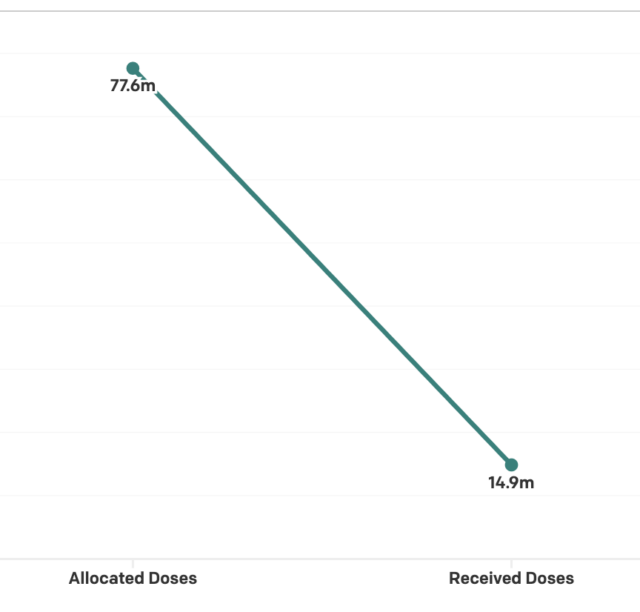Over 1.4 billion COVID-19 vaccine doses have been administered worldwide. This is an impressive feat less than 15 months since the start of the pandemic — but we’re still a long way from reaching everyone, everywhere. Countries in North America and Europe have raced ahead, with national coverage as high as 40-50% of the population in some countries. But other parts of the world are struggling to protect even their most vulnerable citizens and frontline health workers.
At the start of May 2021, less than 1% of vaccines administered globally went to people in low-income countries. African countries are vaccinating, on average, less than 0.04% of their populations every day. At such rates, reaching herd immunity could take years – especially if vaccines remain unavailable.
Here’s a look at the disparities in vaccine roll-outs, the deadly consequences of unequal vaccination, and how world leaders can address this crisis.
Are rich countries sitting on surplus vaccines?
One of the biggest challenges facing efforts to scale up COVID-19 vaccination globally is supply; there simply are not yet enough vaccines to meet the overwhelming global demand. But perhaps more pressing, richer countries — which signed agreements to purchase billions of vaccines — currently hold almost all of the supply. And they purchased enough to vaccine their populations several times over.
While you won’t find stockpiles of vaccines in high-income countries yet, that could change in the next few months. Analysis from the Kaiser Family Foundation found that the supply of vaccines would outstrip demand in the United States before June. ONE applied a similar methodology to all G7 countries to approximate when national supply would exceed demand.
The results show that six countries will reach the tipping point where supply outpaces demand for COVID-19 vaccines by the end of summer — many much sooner. The US will almost certainly reach this tipping point first, followed by Germany, Canada, Italy, France, and the UK.
The table above uses the most recent, credible national polling data available publicly to estimate the number of adults who have said they are willing to get a COVID-19 vaccine in each country. Using vaccination data from Our World in Data, we estimate the number of days it will take to reach all willing adults with at least one dose. Read more about our methodology and doses.
These same countries have purchased enough doses to vaccinate their entire population and still have more than 1 billion doses left over. These surplus doses could start stacking up when national demand for vaccines falls below supply.
How can world leaders increase global access to vaccines?
The Access to COVID-19 Tools Accelerator (ACT-A) and COVAX remain the best mechanisms to help deliver vaccines and therapeutics to low-income counties at scale and at speed. However, COVAX remains underfunded and has struggled to find enough doses for low- and middle-income countries to vaccinate the 20-30% of their population who are most vulnerable to the virus.
COVAX urgently needs to secure an additional $2 billion of donor funding by June to increase vaccination rates in low- and middle-income countries, purchase more vaccines, and prepare to fight variants. Countries will have a chance to step up and fund COVAX this June during the COVAX summit.
The countries that will have surplus vaccines in the next few months should also start sharing them with COVAX immediately so that they can be used to protect vulnerable people in other parts of the world. Read more on our proposals for sharing excess doses.
Why this all matters for the COVID-19 responses in all countries
Evidence shows that these inequities will prolong the pandemic globally. The longer the virus remains unchecked anywhere on the planet, it will continue to mutate, breach borders, and wreak havoc on communities and the global economy:
- There could be twice as many deaths from COVID-19 if rich countries continue to monopolize the first doses of vaccines instead of distributing them globally.
- Vaccine hoarding could cost the global economy up to $9.2 trillion. Rich countries will bear half those costs because of supply chain disruptions and demand shocks.
- Each new infection is an opportunity for mutation. Already there are over 4,000 COVID-19 variants and some – like the South African and UK variants – are proving more transmissible than other strains. And with each new strain, the higher the risk of the disease evolving to an extent where current vaccines, diagnostics, and treatments no longer work.
How to prevent a prolonged pandemic
The only way to prevent new and possibly more dangerous variants is to dramatically slow transmission of the virus through widespread vaccination. We are calling on G7 countries to help redress this situation with a comprehensive, coordinated strategy to get to global herd immunity as soon as possible. This should include increasing the global supply of all COVID tools through investment, policies, and the redistribution of excess doses. Leaders must also agree to a burden sharing model and begin to plug the gap by fully funding ACT-A and COVAX.



